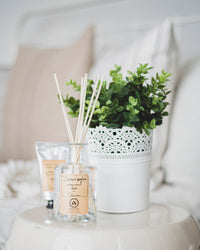What causes dry skin and what can you do about it? Learn how to best take care of you skin this winter and establish a skincare regime you can stick by getting back to the basics: hydrating, exfoliating, and moisturizing.
What is dry skin?
Your skin is made up of three layers. The innermost layer is your subcutaneous fat that provides insulation, energy storage, and shock absorption. Next is your dermis, which is where your blood vessels, nerves, sweat and oil glands, and hair follicles reside.
The top layer is your epidermis. It has stacked layers of cells. Your older cells will eventually die and fall off by rising to the top of the cells. Your strateum corneum is made up of these dead skin cells, and may affect your appearance if the water content of all the layers below are low.

In winter, humidity is much lower both indoors and outdoors, and affects the water content in your skin. Your skin is porous, and water evaporates from it all the time. Wind and low humidity can accelerate this process. The result is known as the ‘winter itch’ or winter xerosis that causes flaking and cracks in the skin.
Skin types can also greatly affect the appearance of your skin, and how you care for it. There is normal, dry, oily, and combination skin. Take your skin type into consideration when formulating your skincare routine.
Step One: Hydrate
It may sound obvious, but the best thing you can do for your skin is to stay well hydrated. It’s recommended that we drink four to six cups of water a day to help with everything from carrying nutrients to your cells, and stabilizing your heartbeat. It also helps to protect your organs and tissues, so that you look and feel great.

For external factors, like the weather, you can also use a humidifier indoors, and aim to keep the humidity levels around sixty percent to help ensure your skin isn’t being dried out by your environment. Likewise, it’s a good idea to reduce your shower or bath time to only 5 or 10 minutes. You should also try to use lukewarm water instead of hot water and be sure to pat or blot your skin when drying off.
Step Two: Exfoliate
Exfoliation is the process of removing dead skin cells from the outermost layer of your skin. In fact, your skin will shed dead skin cells naturally every 28 days. So what is the advantage of exfoliation?
For one, over the years our bodies take longer and longer to achieve this skin cell turnover and may require an extra helping hand. Exfoliation can also improve the appearance of your skin, help to prevent clogged pores, and may increase your collagen production. Collagen is a protein that increases skin elasticity and can help minimize the appearance of fine lines or sagging.
Some people exfoliate daily, and others only once a week. No matter your skin type, you need to remember to listen to your body. Over-exfoliating can leave your skin red and irritated. So pay attention to any negative changes in your skin, and modify your exfoliation schedule accordingly.
There are so many great natural exfoliating products to choose from. Pumice stones are perfect for rough skin on your areas like your hands or feet. While scrubbing belts are going to be your new shower BFF, allowing you to easily exfoliate and stimulate blood circulation even in hard-to-reach places like your back. Or you can try a dry brush to gently buff away dead skin cells, working from your feet upwards in circular motions before you even get in the shower.
If you need a quick and easy solution, try using a gentle exfoliating soap to help your body shed those stubborn dead skin cells and help to leave you with a clean and fresh glow – the perfect two-in-one.
Step Three: Moisturize
Even though your body has a natural lubrication system with glands that secrete oils, our skin still needs a helping hand to protect from the sun, weather and harsh chemicals. This is where moisturizers step in.
There are several types of moisturizers, which protect your skin in different ways. Emollients help to fill the cracks between your cells to seal in water, and provide a smoother and soft complexion. Mineral oils, coconut oil and other plant-based oils are all types of natural emollients. Occlusives act as a thick barrier to prevent water loss in your skin, and work great on areas like your hands, feet, elbows and knees. Shea butter, petrolatum and beeswax are all examples of occlusives. Humectants are meant to draw water to the top layer of your skin, which include ingredients like glycerin and hyaluronic acid.
Be sure to apply your moisturizer when your skin is still moist for best results. Particularly after exfoliating, dermatologists insist that you need to moisturize. Exfoliating can be drying to the skin even when done well. Be sure to use a quality moisturizer to help hydrate your skin. Bonus, your skin will absorb your moisturizer much better after exfoliating so your skin will feel extra soft and smooth.
How do you establish and stick to a new routine? Let us know your helpful tips and tricks.


